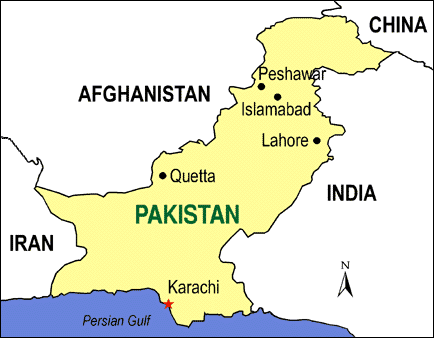Oriental Rugs and Rug Weaving in Pakistan
Geometric Bokharas from Pakistan….
Bokhara production is centered around the city of Lahore. The name for this type comes from the city of Bukhara in Uzbekistan. A century ago rugs in designs like modern Bokharas were woven by Turkomans north of present day Afghanistan. Turkomans bartered rugs for goods they could not produce themselves, and many of their weavings accumulated in bazaar cities like Bokhara. Eventually the name of the city became associated with the rugs themselves, and this historical misnomer continues today.
SIZE: Sizes include very small mats (as small as 1' x 1'), scatters, runners, and large carpets.
STRUCTURE: cotton warp and weft (old Turkomans were almost always on wool foundation) in a huge variety of qualities, from really bad rugs with fewer than 50 knots per sq. in. to very tightly woven pieces with over 288 knots per sq. in. Most Bokharas have wool pile, but some have "silk" inlay (a common market name for this type is "Jaldar"). This "silk" is almost always artificial silk–cotton mercerized to look like silk. Bokharas with artificial silk inlay are usually not very good quality rugs.
Most Bokharas are made of finely spun, soft wool. New Zealand wool is commonly used, and this can make a shiny, glossy finish that almost looks like silk. Fine Bokharas are often closely clipped (so that their intricate designs are crisp and clear), but some Bokharas are left especially thick for their quality.
COLOR & DESIGN: red and rust fields are most common, but Bokharas can have ivory, navy, green, slate, teal, peach, rose or orange backgrounds. The most common design consists of rows of "Tekke" guls or medallions (the Tekkes were one of the Turkoman tribes who wove a design so distinctive as to become essentially a totem of the tribe). Other Bokhara designs also related to Turkoman styles are found, and like Tekkes, these rugs are usually named after the Turkoman tribal group which made the kind of rug they most resemble (examples are Yomud, Salor, and Ersari).
Bokharas are always in stock in a wide variety of sizes, colors, and qualities.
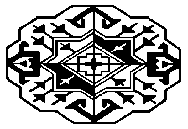 A Tekke gul (medallion), the most common design element in Bokharas. A Tekke gul (medallion), the most common design element in Bokharas. |
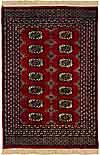 BOKHARA BOKHARAThick nap of New Zealand wool. Wool on cotton; 144 knots/sq. in. 6' x 9' |
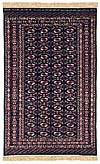 BOKHARA BOKHARAClosely clipped with Yomud design. Wool on cotton; 242 knots/sq. in. 3' x 5' |
Floral Persian Design Rugs from Pakistan….
In recent years, moderate quantities of rugs of very fine quality in Persian design have come from Pakistan. These are often very nice wool rugs.
SIZE: small scatters through large carpets; relatively few runners are available.
STRUCTURE: cotton warp and weft in only a few qualities. Most production is in "16/16" weave (256 knots per sq. in.). "16/18" is often claimed, and sometimes actually woven. Some lesser quality weaves are available (12/12, 14/14), but these are usually more expensive than the 150 knot rugs from India, and so not as good a value. Pile is wool, and almost always closely clipped.
COLOR & DESIGN: in the past these "city" rugs most often came in the classic floral motifs of Kashan, Tabriz, and Isfahan, but in the last few years there has been a marked trend toward Aubusson and rococo European designs.
Colors are extremely varied, from traditional reds and blues and rich earth tones trough mauve, teal, emerald, peach, and grey.
Fine Persian design rugs from Pakistan like these are always in stock in a wide variety of sizes, colors, and qualities.
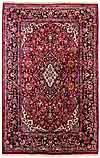 KASHAN KASHANTraditional medallion design. Wool on cotton; 288 knots/sq. in. 6' x 9'5" |
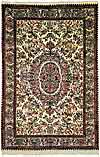 AUBUSSON AUBUSSONEuropean designs are common today. Wool on cotton; 288 knots/sq. in. 6' x 9' |
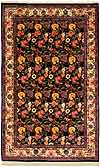 KASHAN KASHANA typical all-over design. Wool on cotton; 256 knots/sq. in. 4' x 6' |
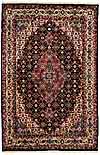 TABRIZ TABRIZHerati design with medallion. Wool on cotton; 254 knots/sq. in. 4' x 6' |
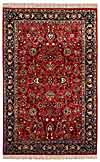 KASHAN KASHANAll-over "Shah Abbas" design. Wool on cotton; 288 knots/sq. in. 4' x 6' |
Vegetable-Dyed Village Rugs from Pakistan….
In the last decade there have begun to appear some very interesting village rugs from Pakistan made with vegetable dyes and handspun wool. Most of these rugs are woven by Afghans in the area between Peshawar and Islamabad.
SIZE: scatters through medium-size carpets; some runners.
STRUCTURE: cotton warp and weft is most common, but some pieces are woven on wool warp with cotton weft, and some are on all-wool foundation. Most production is in "9/9" weave (81 knots per sq. in), but there is considerable experimentation. At their best, these pieces use excellent handspun Afghan wool. In addition to piled rugs, there is significant production of flat-woven tapestry-technique kilims and soumaks.
COLOR & DESIGN: typical village Persian designs like Herez and Mahal are most often used. Most pieces are geometric in design, but a few are more curvilinear and floral in effect. Because madder and indigo dyes are used, colors usually include rusty red, navy and medium blue, and yellow-green.
There is usually a good supply of vegetable-dyed village rugs like these in stock.
 AFSHAR AFSHARVegetable-dyed wool. Wool on cotton; 81 knots/sq. in. 5'5" x 8'2" |
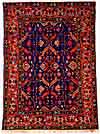 MAHAL MAHALVegetable-dyed wool. Wool on cotton; 81 knots/sq. in. 8'6" x 9'4" |

